I think I spoke too soon.
Lindy passed away on Nov. 15, 1994. Nevertheless, twenty years later, there are people killing Lindy Locsin. No, not the National Artist himself. I'm obviously referring to the diminishing body of work.
The Manadarin Oriental Manila, the Benguet Center, The Hotel InterContinental Manila, were all creations of Leandro V. Locsin. One is gone, one being demolished and another clearly in the firing line.
The Benguet Center
Sadly, this stately building, The Benguet Center, headquarters of Benguet Mining was demolished last 2011. The property was bought by the “good guys” and they plan to erect 3 twisting buildings in the area.
I remember the time when it was being constructed. Only the San Miguel Corporation was between the old Medical City and the site of Benguet Center. It was made using native araal stone. Among all the glorious buildings of Leandro Locsin, this is what moves me the most sublime manner. One has to be a Negrense to feel this. To see a modern building positioned obliquely and wrapped in stone that only comes from our native island of Negros, is a silent tribute to the what the province can bring. Araal stone from the sides of the Kanlaon volcano is the reason why the Benguet Center's color was so unique. In form, a mixture of cubism and flowing layers that only Lindy Locsin can imagine.
 |
| The remains of the Benguet Center. Credits to the owner this photo. |
It is now gone and an architect who admired the building so much was reported to have shed tears when he saw the most beloved creation by Locsin himself was being demolished. All we have now are the photos taken when it was still standing.
As for me, whenever I pass by, I cannot help but wonder what monstrosity will stand in its stead.
Mandarin Oriental Manila
The Mandarin Oriental Manila stands at the corner of Paseo de Roxas and Makati Avenue. Its facade no longer has the spotlights at night. Its lawn has gone from green to brittle brown. No longer will be a hum activity during the Chinese New Year. It is currently being torn down to make way for a new building.
The Mandarin Oriental Manila opened in 1976 just in time for the IMF-WB meeting. But even during its construction, while passing by EDSA, one can see an imposing building being erected.
The Mandarin Oriental Manila was called the “Cultural Center” of Makati owing to the many and regular cultural activities in the hotel. Its Chinese New Year celebration was an awaited event, also its Oktoberfest and numerous food festivals.
Personally, the Mandarin Deli is home to one of the best chocolate cakes I have tasted. It was so delicious and so sweet that it gave me a headache whenever I would sink my teeth into it.
The Captain’s Bar was the place where the likes of Kuh Ledesma, Sharon Cuneta, Martin Nievera, Gary Valenciano and even Ramon Jacinto performed regularly. Its list of guests included British PM Tony Blair, Neil Armstrong, Tom Cruise, Chuck Norris and Christopher Walken among others.
The Mandarin Oriental Manila also played a part in Philippine History. During the December 1989 coup, the Mandarin was one of the strongpoints of the RAM rebels. In fact, Mandarin not only had celebrities and businessmen as guests but also a battalion of Scout Rangers. The hotel was one of the three strongpoints by the RAM Rebels and the pockmarks of bullets were visible after that episode.
Mandarin Oriental Manila had its last guest check out on September 2014. The corner is now dark.
The Hotel InterContinental Manila
The Intercon as it was commonly known was the longest operating chain hotel in the Philippines. It opened its doors on April 11, 1969. A lot of people miss the fact that the Intercon was the first 5 star hotel in Makati. With 332 rooms, its restaurants such as Prince Albert, Bahia and Cafe Jeepney became part of the Makati landscape. And who could ever forget "Where Else?", where we swung the night away only to have to leave in a jiffy because of the martial law curfew (unless of course you were billeted for the night). And speaking of martial law, it was within the confines of Jeepney Cafe, where one could make contrary statements and criticisms against the dictatorship with then Defense Minister Juan Ponce Enrile in hearing distance.
I wonder what it is with Lindy's structures that it figures itself in a coup d'etat. Another time, it was the 2nd strongpoint of the RAM Rebels during the December 1989 coup attempt that closed down the strategic Makati Business District. For whatever it's worth, Lindy Locsin's buildings have survived the crossfire of coup d'etats. Unfortunately, they are all vulnerable to the wrecking ball of "progress".
By December 31, 2015, the Intercon will be closed and will be demolished to make way for another mixed use building complex. Another creation of Lindy Locsin is to be killed, another work of art to be destroyed.
Three works of art. Three monuments to the resilience and best of the Filipino. They say that it is part of progress. But how do we really define progress? Is it just the accumulation of wealth and more money is better? Or is progress to be measured by the ability of a people to construct, erect and preserve the higher aspirations of its people represented by buildings that were created by an artist and participated actively in its development and history? It is time that we decide what is progress and what is retrogression. Once these buildings are gone, they are gone forever and those who remember those buildings will also be gone as mortals.
I can only say in our native tongue, "Ka nugon gid."
Farewell Lindy.
---------------------
Follow me on Twitter @TitasdeBacolod




















